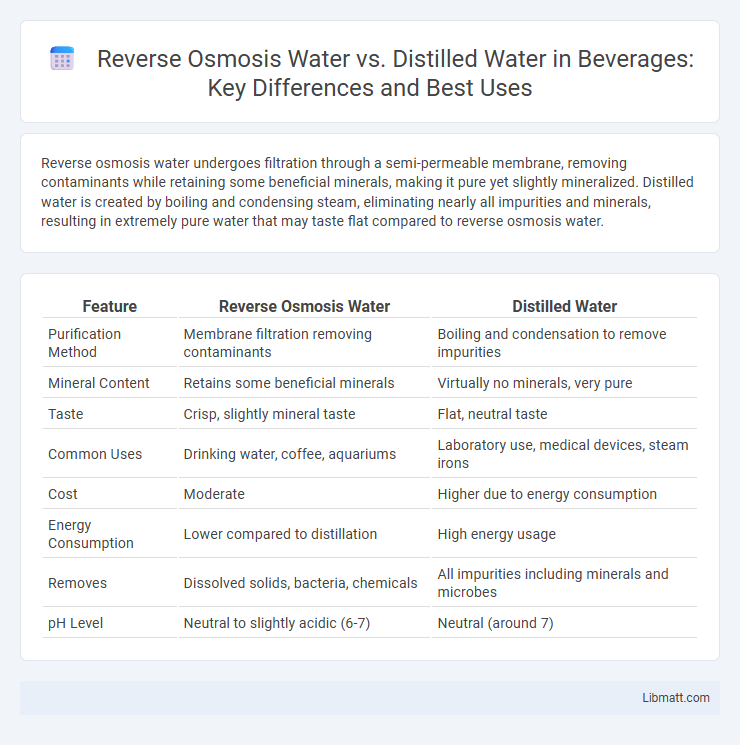Reverse osmosis water undergoes filtration through a semi-permeable membrane, removing contaminants while retaining some beneficial minerals, making it pure yet slightly mineralized. Distilled water is created by boiling and condensing steam, eliminating nearly all impurities and minerals, resulting in extremely pure water that may taste flat compared to reverse osmosis water.
Table of Comparison
| Feature | Reverse Osmosis Water | Distilled Water |
|---|---|---|
| Purification Method | Membrane filtration removing contaminants | Boiling and condensation to remove impurities |
| Mineral Content | Retains some beneficial minerals | Virtually no minerals, very pure |
| Taste | Crisp, slightly mineral taste | Flat, neutral taste |
| Common Uses | Drinking water, coffee, aquariums | Laboratory use, medical devices, steam irons |
| Cost | Moderate | Higher due to energy consumption |
| Energy Consumption | Lower compared to distillation | High energy usage |
| Removes | Dissolved solids, bacteria, chemicals | All impurities including minerals and microbes |
| pH Level | Neutral to slightly acidic (6-7) | Neutral (around 7) |
Introduction to Reverse Osmosis and Distilled Water
Reverse osmosis water is produced by forcing water through a semi-permeable membrane that removes impurities, minerals, and contaminants, resulting in highly purified water. Distilled water is created by boiling water to produce steam, which is then condensed back into liquid, effectively eliminating most minerals and impurities. Both methods generate clean water but differ in their purification processes and mineral content removal efficiency.
How Reverse Osmosis Works
Reverse osmosis works by forcing water through a semipermeable membrane that removes contaminants such as dissolved salts, bacteria, and organic molecules, resulting in purified water. This process effectively reduces impurities while retaining essential minerals in your water, unlike distillation which uses boiling and condensation to remove impurities. Understanding how reverse osmosis works can help you choose a water purification method that best suits your needs for clean, safe drinking water.
The Distillation Process Explained
The distillation process involves boiling water to create steam, which is then condensed back into liquid form, effectively removing impurities and contaminants. This method eliminates minerals, bacteria, viruses, and heavy metals, producing highly purified water. Distilled water is free from dissolved solids, making it ideal for laboratory use and medical applications where mineral-free water is essential.
Key Differences Between RO and Distilled Water
Reverse osmosis water undergoes filtration through a semipermeable membrane to remove contaminants like bacteria, viruses, and dissolved solids, while distilled water is produced by boiling and condensing steam to eliminate impurities. RO water retains some mineral content, enhancing taste and nutritional value, whereas distilled water is completely devoid of minerals, resulting in a flat taste. Both methods produce highly purified water, but RO water is more energy-efficient and commonly used for drinking, while distilled water is preferred for laboratory and medical applications due to its extreme purity.
Water Purity and Mineral Content Comparison
Reverse osmosis water typically contains trace amounts of minerals due to the semipermeable membrane filtering out 90-99% of dissolved solids, making it highly pure but not entirely mineral-free. Distilled water undergoes a boiling and condensation process that removes nearly 100% of minerals and impurities, resulting in ultra-pure water but lacking essential minerals. Your choice between these two depends on whether you prioritize maximum purity or the presence of minimal beneficial minerals in your water.
Taste and Odor: RO vs Distilled Water
Reverse osmosis water retains trace minerals that often contribute to a more balanced and naturally fresh taste compared to the flat and neutral flavor of distilled water, which is stripped of all minerals. The presence of residual minerals in RO water can reduce the sterile, bland odor commonly associated with distilled water. Consequently, RO water is typically favored for drinking due to its improved taste and less pronounced odor.
Health Implications of Drinking Each Type
Reverse osmosis water contains trace minerals that can support electrolyte balance and hydration, making it generally safe and beneficial for daily consumption. Distilled water, lacking minerals, may lead to mineral deficiencies if consumed exclusively over long periods, potentially impacting bone and cardiovascular health. Your choice between these waters should consider your dietary mineral intake and overall health needs.
Home Use: Which Is More Convenient?
Reverse osmosis water offers greater convenience for home use due to its efficient filtration system that removes a wide range of contaminants, ensuring safe and clean drinking water without the need for frequent maintenance. Distilled water, while pure, requires specialized equipment and longer processing times, making it less practical for everyday household consumption. Your choice depends on whether you prioritize ease of access and continuous supply (reverse osmosis) or ultra-purity for specific needs (distilled water).
Environmental Impact Considerations
Reverse osmosis water generally has a lower environmental impact compared to distilled water due to its more energy-efficient filtration process, which requires less electricity and produces less heat. Distilled water production involves boiling water to create steam, consuming significantly more energy and increasing carbon emissions. Choosing reverse osmosis can help reduce your environmental footprint by conserving energy and minimizing greenhouse gas emissions in water purification.
Which Is Better: Reverse Osmosis or Distilled Water?
Reverse osmosis water contains trace minerals and offers superior filtration by removing contaminants, making it ideal for everyday drinking water. Distilled water is free of nearly all impurities, including minerals, resulting in a purer but flatter taste that may lack essential nutrients. Your choice depends on whether you prioritize mineral content for hydration or maximum purity for specialized uses.
Reverse osmosis water vs distilled water Infographic

 libmatt.com
libmatt.com